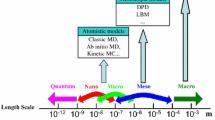Abstract
A new approach to the diffusion-limited reaction rate theory is developed on the base of a similar approach to consideration of Brownian coagulation, recently proposed by the author. The traditional diffusion approach to calculation of the reaction rate is critically analyzed. In particular, it is shown that the traditional approach is applicable only to the special case of reactions with a large reaction radius, \(\bar r_A \ll R_{AB} \ll \bar r_B\) (where \(\bar r_A\), \(\bar r_B\) are the mean interparticle distances), and becomes inappropriate to calculation of the reaction rate in the case of a relatively small reaction radius, \(R_{AB} \ll \bar r_A\), \(\bar r_B\). In the latter, most general case particles collisions occurmainly in the kinetic regime (rather than in the diffusion one) characterized by a homogeneous (at random) spatial distribution of particles. Homogenization of particles distribution occurs owing to particles diffusion mixing on the length scale of the mean interparticle distance with the characteristic diffusion time being small in comparison with the characteristic reaction time. The calculated reaction rate for a small reaction radius in 3D formally (and casually) coincides with the expression derived in the traditional approach for reactions with a large reaction radius, however, notably deviates at large times from the traditional result in the plane (2D) geometry.
Similar content being viewed by others
References
Kotomin, E. and Kuzovkov, V., Modern Aspects of Diffusion-Controlled Reactions, Amsterdam: Elsevier, 1996.
Alberty, R.A. and Hammes, G.G., Application of the Theory of Diffusion-Controlled Reactions to Enzyme Kinetics, J. Phys. Chem., 1958, no. 62, pp. 154–159.
Murray, J.D., Mathematical Biology I: An Introduction, 3d ed., New York: Springer, 2002.
Murray, J.D., Mathematical Biology II: SpatialModels and Biomedical Applications, 3d ed., New York: Springer, 2003.
Case, T.J., An Illustrated Guide to Theoretical Ecology, Oxford: Oxford University Press, 2000.
Corbett, J.W., Solid State Physics, 1966, suppl. 17, p. 36.
Collins, F. and Kimball, G., J. Colloid Sci., 1949, no. 4, p. 425.
Waite, T.R., Phys. Rev., 1957, no. 107, p. 463.
Smoluchowski, M., Versuch einer Mathematischen Theorie der Koagulationskinetik Kolloider Lösungen, Zeitschrift für Physikalische Chemie, 1917, no. 92, pp. 129–154.
Fuchs, N.A., The Mechanics of Aerosols, New York: Pergamon, 1964.
Burlatskii, S.F., Oshanin, G.S., and Ovchinnikov, A.A., Chem. Phys., 1991, no. 152, pp. 13–21.
Lindenberg, K., West, B.J., and Kopelman, R., Phys. Rev. A, 1990, no. 42, p. 890.
Lindenberg, K., Argyrakis, P., and Kopelman, R., Reaction-Diffusion Model for A + A Reaction, J. Phys. Chem., 1995, no. 99, pp. 7542–7556.
Torney, D.V. and McConnell, H.M., J. Phys. Chem., 1983, no. 87, p. 1941.
Torney, D.C. and McConnell, H.M., Proc. R. Soc. London A, 1983, no. 387, pp. 147–170.
Axelrod, D., J. Membr. Biol., 1983, no. 75, pp. 1–10.
Goesele, U. and Huntley, F.A., Phys. Lett. A, 1975, vol. 55, pp. 291–292.
Geguzin, Ya.E. and Krivoglaz, M.A., Migration of Macroscopic Precipitates in Solid Materials, Moscow, 1971.
Beere, W., J. Nucl. Mater., 1984, no. 120, pp. 88–93.
Veshchunov, M.S., On the Theory of Brownian Coagulation, J. Eng. Therm., 2010, vol. 19, no. 2, 62–74.
Azarov, I.B. and Veshchunov, M.S., Development of the New Approach to the Brownian Coagulation Theory: Transition Regime, J. Eng. Therm., 2010, vol. 19, no. 3, 128–137.
Veshchunov, M.S., A New Approach to the Brownian Coagulation Theory, J. Aerosol Sci., 2010, no. 41, pp. 895–910.
Chandrasekhar, S., Stochastic Problems in Physics and Astronomy, Rev. Mod. Phys., 1943, no. 15, pp. 1–89.
Noyes, R.M., Progress in Reaction Kinetics, Porter, G., Ed., New York: Pergamon, vol. 1, pp. 128–160, 1961.
Duesing, G., Hemmerich, H., Sassin, W., and Schilling, W., Int. Conf. on Vacancies and Interstitials in Metals, vol. 1, Juelich, Germany, 1968, p. 246.
Schilling, W. and Ullmaier, H., in Materials Science and Technology, Frost, B.R., Ed., vol. 10B, pt. 2, chap. 9, New York: VCH, 1994, p. 180.
Rest, J. and Hofman, G.L., J. Nucl. Mater., 2000, no. 277, p. 231.
Ovchinnikov, A.A. and Zeldovich, Ya.B., Chem. Phys., 1978, no. 28, p. 215.
Toussaint, D. and Wilczek, F.J., Chem. Phys., 1983, no. 78, p. 2642.
Lee, B.P. and Cardy, J., J. Stat. Phys., 1995, no. 80, pp. 971–1007.
Täuber, U.C., Howard, M., and Vollmayr-Lee, B.P., J. Phys. A: Math. Gen., 2005, no. 38, R79–R131.
Carslaw, H.S. and Jaeger, J.C., Conduction of Heat in Solids, 2nd ed., Oxford Univ. Press, 1959.
Burlatsky, S.F. and Moreau, F., Phys. Rev. E, 1995, no. 51, p. 2363.
Bramson, M. and Lebowitz, J.L., Phys. Rev. Lett., 1988, no. 61, pp. 2397–2400.
Bramson, M. and Lebowitz, J.L., Phys. A: Stat. Mech. Its Appl., 1990, no. 168, pp. 88–94.
Kolmogorov, N. and Leontovich, M.A., Phys. Z. Sowjetunion, 1933, no. 4, p. 1.
Author information
Authors and Affiliations
Corresponding author
Rights and permissions
About this article
Cite this article
Veshchunov, M.S. A new approach to diffusion-limited reaction rate theory. J. Engin. Thermophys. 20, 260–271 (2011). https://doi.org/10.1134/S1810232811030040
Received:
Published:
Issue Date:
DOI: https://doi.org/10.1134/S1810232811030040




